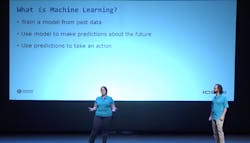Last year at the Ignition Community conference, Inductive Automation’s Kevin McClusky (co-director of sales engineering) and Kathy Applebaum (senior software engineer) explored the various ways in which machine learning can be applied in industry. In this presentation, they delved deep into the types of machine learning that are most applicable to industry and the algorithms behind them. You can read more about this 2018 presentation in the article “How to Apply Industrial Machine Learning,” which was based on that presentation.
At this year’s event, McClusky and Applebaum came together again to highlight the integration of more machine learning capabilities into Ignition over the past year, as well as to showcase four industrial use cases of machine learning being explored by Ignition users.
Newly available machine learning capabilities in Ignition enable users to take advantage of the Apache Math 3 library previously added to Ignition 7.9.10 just prior to the release of Ignition 8. The addition of this library provided access to K-means, genetic and regression algorithms, and neural networks, said Applebaum. “The templates we’re releasing now take advantage of this scripting to apply machine learning directly to Ignition projects without having to go to cloud,” she added
During the presentation, McClusky showed how these capabilities can be used in Ignition with templates in the software’s Vision application and in its Perspective application views. He also highlighted how CSE Icon, Streamline Innovations, Andritz Automation, and The Integration Group of America (TIGA) are applying machine learning with Ignition.
CSE Icon is a system integration firm focused on the oil and gas industry. According to McClusky, CSE Icon has been finding success with machine learning by creating models and running algorithms to solve common oil and gas industry problems. “It can be difficult to determine the optimal operating point on a well based on all the variables,” he said. But by using classification (linear discriminant analysis) and linear regression with Python, CSE has been able to isolate a variety of measurements and historical data they can use to train machine learning algorithms. These insights are being used in applications such as well optimization and artificial lift optimization and prediction.
Applebaum noted that Python, a general-purpose programming language, is built into Ignition and includes libraries for machine learning applications. She added that new templates are being included in Ignition so that machine learning can be done with Python directly in Ignition, rather than using an external system tied to it.
Streamline Innovations (featured in “Today’s Digital Transformation Reality”) is using Python in Ignition to do linear regression analyses. The company is looking to apply its findings to the chemical process it uses to remove toxic hydrogen sulfide from natural gas. Streamline Innovations plants create elemental sulfur which removes hydrogen sulfide in a chemical reaction that needs to be controlled precisely. McClusky noted that Streamline Innovations is using machine learning to provide advanced control efficiencies, create a fully self-tuning system, and to continue increasing operational efficiencies for this highly sensitive process.
Andritz Automation is looking to leverage machine learning to run its plants autonomously. “First, they use simulation software, separate from Ignition, to simulate a plant,” McClusky said. “Then they take Ignition and connect it to this simulation to train Ignition’s machine learning models so they can learn how to run the plant. You can simulate all kinds of conditions to train this model and see [in the simulation] how well it performs with the recommendations made by the models. If it gets trained well enough, the simulator could be removed, with the model then being connected directly to the plant to run it.
McClusky noted that, for these applications, Andritz is using Markov Decision Problems and Decision Trees via Python and TensorFlow, an open source symbolic math library for machine learning. “Markov Decision Problems are a form of reinforcement learning combining exploration and exploitation to maximize cumulative reward and avoid the pitfalls of selecting short-term rewards that ultimately lead to bad outcomes,” explained Applebaum.
Like CSE Icon, TIGA is a system integration firm focused on using machine learning in the oil and gas industries to address core operating issues. The types of issues TIGA targets include tank leak detection, decline curve analysis (in terms of how a well will produce less and less over time), pipeline corrosion prediction, and geological feature identification to boost exploration outcomes. McClusky said TIGA is using geologic data, along with past performance data, in machine learning classification applications (such as k-nearest neighbor, logistics regression, and random forests regression) to identify new areas—based on geologic composition—that are most likely to deliver positive results from exploratory drilling.
Though the application of machine learning today remains challenging from the perspective of any end user, the advances made in Ignition over the past year clearly show how machine learning is no longer just a tool for data scientists. It is quickly moving toward more common use by manufacturing engineers.
About the Author
David Greenfield, editor in chief
Editor in Chief

Leaders relevant to this article:
